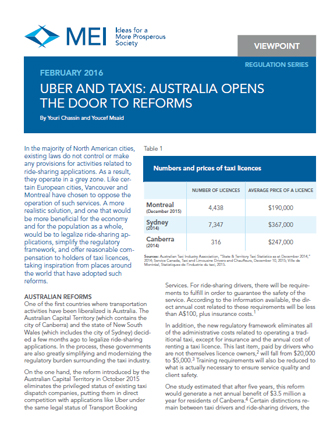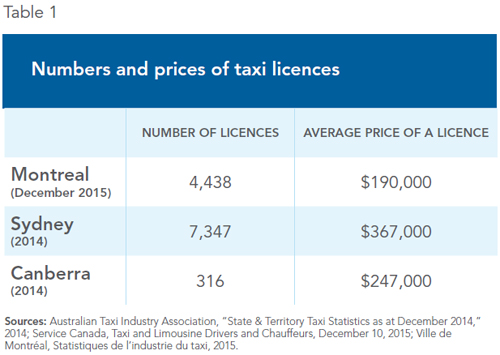Viewpoint – Uber and Taxis: Australia Opens the Door to Reforms

In the majority of North American cities, existing laws do not control or make any provisions for activities related to ride-sharing applications. As a result, they operate in a grey zone. Like certain European cities, Vancouver and Montreal have chosen to oppose the operation of such services. A more realistic solution, and one that would be more beneficial for the economy and for the population as a whole, would be to legalize ride-sharing applications, simplify the regulatory framework, and offer reasonable compensation to holders of taxi licences, taking inspiration from places around the world that have adopted such reforms.
Media release: Uber and taxis: solutions for a peaceful coexistence
Ride-Sharing Applications and the Future of Urban Transportation: Viewpoint describing how everyone will benefit from ride-sharing applications (Nov. 2014)
 Links of interest
Links of interest
 |
 |
 |
|
Interview (in French) with Youri Chassin (Québec aujourd'hui, BLVD 102.1, February 8, 2016)
Interview (in French) with Youri Chassin (Bouchard en parle, FM93, February 8, 2016) |
Viewpoint – Uber and Taxis: Australia Opens the Door to Reforms
In the majority of North American cities, existing laws do not control or make any provisions for activities related to ride-sharing applications. As a result, they operate in a grey zone. Like certain European cities, Vancouver and Montreal have chosen to oppose the operation of such services. A more realistic solution, and one that would be more beneficial for the economy and for the population as a whole, would be to legalize ride-sharing applications, simplify the regulatory framework, and offer reasonable compensation to holders of taxi licences, taking inspiration from places around the world that have adopted such reforms.
Australian Reforms
One of the first countries where transportation activities have been liberalized is Australia. The Australian Capital Territory (which contains the city of Canberra) and the state of New South Wales (which includes the city of Sydney) decided a few months ago to legalize ride-sharing applications. In the process, these governments are also greatly simplifying and modernizing the regulatory burden surrounding the taxi industry.
On the one hand, the reform introduced by the Australian Capital Territory in October 2015 eliminates the privileged status of existing taxi dispatch companies, putting them in direct competition with applications like Uber under the same legal status of Transport Booking Services. For ride-sharing drivers, there will be requirements to fulfill in order to guarantee the safety of the service. According to the information available, the direct annual cost related to these requirements will be less than A$100, plus insurance costs.(1)
In addition, the new regulatory framework eliminates all of the administrative costs related to operating a traditional taxi, except for insurance and the annual cost of renting a taxi licence. This last item, paid by drivers who are not themselves licence owners,(2) will fall from $20,000 to $5,000.(3) Training requirements will also be reduced to what is actually necessary to ensure service quality and client safety.
One study estimated that after five years, this reform would generate a net annual benefit of $3.5 million a year for residents of Canberra.(4) Certain distinctions remain between taxi drivers and ride-sharing drivers, the most important being that only taxi drivers can pick up spontaneous fares.
This privilege will also be preserved for drivers working in the state of New South Wales. This regulation offers a considerable advantage given that in Sydney, the capital of this state, spontaneous fares represent around 70% of taxis’ sales revenue.(5) Additionally, the number of available taxi licences will continue to be regulated.
Finally, in New South Wales, owners of taxi licences will receive compensation for their financial losses stemming from the regulatory change. The government therefore recognizes its share of responsibility in the difficult situation of certain taxi owners who have incurred substantial costs for the right to ply their trade. The objective is to indemnify drivers who own one, or up to two, licences.
The details of this assistance to the industry remain to be clarified, but official documents mention an amount of $20,000 per licence for long-time owners.(6) More recent owners would be compensated more generously, by an amount that could go up to $175,000 for a licence purchased in 2015, which is less than half the average price of a licence (see Table 1 for numbers of licences and average prices).

These compensations will be financed in their entirety by a temporary $1-per-ride tax, applicable both to traditional taxis and to services like Uber. In all, the government of New South Wales estimates that the compensation offered to the traditional taxi industry should reach $250 million over five years. The reduced administrative burden should for its part entail annual savings of $30 million.(7)
The Situation in Canada
Two weeks ago, Edmonton became the first Canadian city to officially announce the legalization of ride-sharing applications.(8) Companies will have to pay $70,000 a year to the City to operate their services, as well as six cents per ride to finance the costs of implementing the regulation. Their drivers will all need to have insurance in order to offer the service. No compensation has been offered to taxi drivers, despite the predictable reduction in value of their licences.
Toronto, Ottawa, and Waterloo have announced their intention to reform their regulations in order to allow ride-sharing applications to operate. This is also the path suggested by the Canadian Competition Bureau.(9)
Conclusion
Like all technological innovations that meet a fundamental need, ride-sharing applications will continue to exist and evolve, in spite of the opposition of certain cities and the taxi industry’s rearguard actions. The best way to break through this impasse is to allow competition, and ideally to accompany this reform with a compensation plan for those who find themselves, today, prisoners of an obsolete system.
This Viewpoint was prepared by Youri Chassin, Economist and Research Director at the Montreal Economic Institute, who holds a master’s degree in economics (Université de Montréal), and Youcef Msaid, Associate Researcher at the MEI. The MEI’s Regulation Series seeks to examine the often unintended consequences for individuals and businesses of various laws and rules, in contrast with their stated goals.
References
1. Government of the Australian Capital Territory, Chief Minister, Treasury and Economic Development Directorate, “ACT Taxi Industry Innovation Reforms: Fees and Charges,” September 2015.
2. During a prior reform, the Australian Capital Territory stopped selling taxi licences to instead rent new licences on an annual basis.
3. Op. cit., footnote 1.
4. See Centre for International Economics, Modelling of Policy Scenarios for the ACT On-Demand Transport Sector, August 2015.
5. Government of New South Wales, “Taxi and Hire Car Licence Holders FAQs,” February 2016.
6. Ibid.
7. Misa Han, “Uber passengers to pay $1 extra for trips to compensate taxi licence holders,” Financial Review, December 17, 2015.
8. Elise Stolte and Gordon Kent, “Uber: The ins and outs of what Edmonton City Council passed for it and the taxi industry,” Edmonton Journal, January 28, 2016.
9. Competition Bureau, Modernizing Regulation in the Canadian Taxi Industry, Section 3, November 26, 2015.

